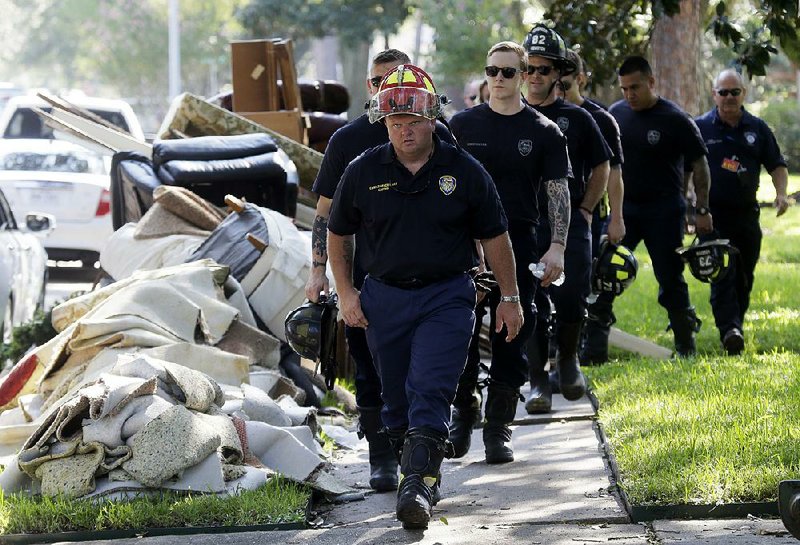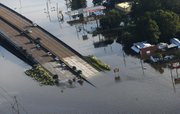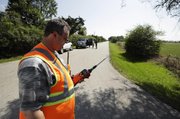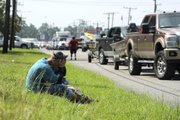HOUSTON -- Rescuers conducted a block-by-block search of tens of thousands of Houston homes Thursday, pounding on doors and shouting as they looked for anyone -- alive or dead -- who was left behind in Harvey's floodwaters.
Elsewhere, Vice President Mike Pence helped clear storm debris in Rockport and comforted Texans grappling in the aftermath of Harvey's destruction.
More than 200 firefighters, police officers and members of a search-and-rescue team fanned out across Houston's Meyerland neighborhood to search for survivors and bodies. Firefighters on Thursday night were finishing the first of six areas they plan to search.
Fire Chief Sam Pena said firefighters hope to complete the checks in all six areas today.
"We don't think we're going to find any humans, but we're prepared if we do," said District Chief James Pennington of the Houston Fire Department.
The confirmed death toll stood at 39, although it is expected to rise. By midday Thursday, the temporary command center in a J.C. Penney parking lot had received no reports of more bodies found during the searches, which are expected to take up to two weeks.
Rather than spray-painting neon X's on the outsides of homes they checked, as rescuers in New Orleans did 12 years ago in the aftermath of Hurricane Katrina, crews in Houston used GPS devices to log the homes. That avoids alerting potential thieves that the homes may be vacant.
Mayor Sylvester Turner said parts of the east and west sides of the city are still flooded, but the rest of Houston is "drying out and drying out well," and traffic is returning to the streets.
[STORM TRACKER: Follow Harvey’s projected path]
Turner said Houston is "turning the corner," with fewer people staying in emergency shelters.
Houston public schools Thursday pushed back the start of classes by two weeks. The nation's seventh-largest district had been scheduled to reopen Monday but will now begin school on Sept. 11.
Houston's two major airports were slowly resuming full service. Limited bus and light-rail service had also resumed, as well as trash pickup.
Jeff Lindner, a meteorologist for the Harris County Flood Control District, estimated that Harvey flooded 136,000 structures in Harris County, or 10 percent of all structures in the county database. He said 70 percent of the county's landmass, about 1,300 square miles, was submerged by at least 1½ feet of water.
As floodwaters receded in Houston, attention shifted a bit to a region near the Texas-Louisiana state line.
Some residents in Beaumont, Texas, grew anxious after the city of nearly 120,000 people lost water service when its main pump station became overwhelmed by the swollen Neches River. Also, officials said flooded roads were making it difficult to set up bottled-water distribution stations.
On Thursday, a procession of about 10 vehicles carrying people searching for water followed a pickup that was towing a trailer packed with bottled water for emergency workers. The truck circled a downtown Beaumont block before Letorisha Hollier hopped out of the first car in the procession. "Give us a case!" Hollier shouted. Her persistence paid off as a firefighter handed her the water.
The lack of water forced Baptist Beaumont Hospital to move patients by ambulances and helicopters to other facilities, including some who had been taken there from flooded nursing homes. Hospital spokesman Mary Poole said the hospital was able to discharge some other patients.
In nearby Port Arthur, the Coast Guard used baskets and harnesses to pull people out of a neighborhood where water was chest-deep. Many residents of second-floor apartments decided to stay.
Harvey initially roared ashore as a Category 4 hurricane in Texas on Aug. 25, then went back out to sea and lingered off the coast as a tropical storm for days, inundating flood-prone Houston.
The storm dropped close to 52 inches of rain, the heaviest tropical downpour ever recorded in the continental U.S.
Although it has been downgraded to a tropical depression, Harvey is still expected to dump heavy rain on parts of Louisiana, Tennessee and Kentucky through today.
Texas' latest statewide damage surveys revealed the scope of the destruction. The figures from the Texas Department of Public Safety indicated that nearly 50,000 homes had minor damage and 37,000 had major damage. At least 6,800 homes were destroyed.
About 325,000 people have sought federal emergency aid in the wake of Harvey. More than $57 million in individual assistance has already been paid out, Federal Emergency Management Agency officials said.
As rescues continue, so does the search for shelter among people left homeless by the storm. Emergency officials reported 32,000 people in shelters across Texas.
A FEMA official in Harris County, which encompasses Houston, said the agency was looking for ways to house people who lost their homes. The priority is to get them into temporary housing, with hotels being one option, he said.
"Right now, nothing is off the table," Tom Fargione said. "This is a tremendous disaster in terms of size and scope. I want to get thinking beyond traditional methodologies you've seen in the past."
CHEMICAL WORRIES
In Crosby, Texas, 30 miles northeast of downtown Houston, at least 2 tons of unstable chemicals used in such products as plastics and paint exploded and burned at a flood-crippled plant early Thursday, sending up a plume of acrid black smoke.
The blaze at the Arkema Inc. chemical plant burned out around midday Thursday, but emergency crews continued to hold back because of the danger that eight other trailers containing the same compound could explode, too.
No serious injuries were reported, although 15 sheriff's deputies went to the hospital after inhaling fumes from the plant, the Harris County sheriff's office said on Twitter. The officers were examined and released.
Long initially described the smoke as "incredibly dangerous," although the agency later backed away from that statement, saying the administrator had spoken out of an abundance of caution.
The Environmental Protection Agency and Texas environmental regulators called the health risks minimal but urged residents downwind to stay indoors with windows closed to avoid inhaling the smoke. The Texas environmental agency called the smoke "especially acrid and irritating" and said it can impair breathing and inflame the eyes, nose and throat.
Two explosions in the middle of the night blew open a trailer containing the chemicals, lighting up the sky with 30- to 40-foot flames, authorities said. Aerial footage showed a trailer, its sides melted, burning in a flooded lot.
On Thursday, Rich Rennard, an executive at Arkema, said the chemical compounds had been transferred to refrigerated containers after the plant lost electricity. But he said those containers failed, too, causing the chemicals in one unit to burn. Rennard said more explosions are expected from the remaining containers.
When the chemicals warm, they start to decompose, which creates more heat and can quickly lead to a rapid, explosive reaction. Some organic peroxides also produce flammable vapors as they decompose. The plant was shut down Aug. 25 as Hurricane Harvey neared, and a skeleton crew of 11 was left behind to ensure that the chemicals remained safe in cold storage.
All employees were removed from the plant before the blasts, and as many as 5,000 people who live within 1½ miles of the plant had been warned Tuesday to evacuate.
Texas A&M chemical safety expert Sam Mannan said the risk management plan that Arkema was required by state and federal law to develop did not address how it would deal with power and refrigeration failures or flooding.
A 2016 analysis that he conducted with university colleagues ranked the Crosby plant among the 70 or so facilities with the biggest potential to cause harm in greater Houston. That finding was based on such factors as the type and amount of chemicals and the population density.
Officials with Arkema, which is based in France, did not immediately return calls on the plant's contingency planning.
Rachel Moreno, a spokesman for the fire marshal of Harris County, would not discuss details of the risk management plan, such as how high up the plant's backup generators sit.
Arkema officials did not directly notify area emergency managers about the generator failure, Moreno said. The warning instead came by way of the plant's workers, who told the Crosby Volunteer Fire Department about it when they were rescued during the storm, she said.
PENCE PITCHES IN
In Rockport, Pence donned blue work gloves to clear debris and dispensed hugs. The extent of the ruin was measured in the mounds of black garbage bags heaped outside nearly every home. Pence, wearing jeans and cowboy boots, worked up a sweat in the 90-degree heat as he helped clear tree limbs at one boarded-up residence.
"We're going to stay with you every step until we bring southeast Texas back bigger and better than ever before," Pence promised the crowd that gathered at a church damaged by Harvey. The vice president's wife, Karen Pence, offered a prayer seeking blessings for those affected by the storm.
Brittany Naro of Corpus Christi, who was on hand at a home that Pence visited, said his presence meant a lot "because this is devastating."
Speaking of Pence and President Donald Trump, she added: "They didn't have to come. What more can you ask for?"
While Pence's visit, which also included him touring the area aboard a V-22 Osprey military aircraft, was about making personal connections with storm victims and volunteers helping in the recovery effort, Trump's Tuesday trip to Corpus Christi and Austin focused on meeting with state and local emergency management officials.
The president drew some criticism for not directly mentioning the loss of life and the suffering of hurricane victims during his visit. And Trump saw little damage during his visit to Corpus Christi. Mostly, he saw boarded-up windows, a few downed tree limbs and fences askew.
The president plans to return to the storm region Saturday, with stops in inundated Houston and Lake Charles, La.
Energy Secretary Rick Perry, a former Texas governor who joined Pence on Thursday's trip, said the president had been eager to make an early visit to those directly affected by the storm but was advised to instead travel to Corpus Christi or Austin, "where no search-and-rescue resources would be pulled away."
Pence also was joined by Texas Gov. Greg Abbott, several other Cabinet members and the Rev. Franklin Graham, who took volunteers from his aid agency, Samaritan's Purse, to help with the cleanup.
The vice president made a stop at a food distribution center in Victoria, Texas. He said later at a news conference in Corpus Christi that he and his wife were moved by the work of volunteers.
"To see the outpouring of compassion and concern was deeply inspiring to us," Pence said. "Every American should know that even in this difficult time, this disastrous storm, the very best of the people of Texas and the very best of the people of America are shining forth."
White House spokesman Sarah Huckabee Sanders said Thursday that Trump pledged to personally donate $1 million to storm victims in Texas and Louisiana.
"He would like to join in the efforts that a lot of the people that we've seen across this country do," she said.
Sanders said the president hasn't decided when or where he will send the donation.
Congress, meanwhile, is gearing up for a vote as early as next week on a multibillion-dollar down payment on relief aid related to Harvey.
White House and congressional aides said Thursday that an emergency request to replenish rapidly shrinking aid reserves was coming from the Trump administration as early as today and that votes in the U.S. House and Senate would quickly follow.
Administration officials said the White House proposal calls for an initial $5.9 billion package in Harvey recovery aid. The money would be a down payment for immediate recovery efforts, to be followed by a larger aid package later, White House homeland security adviser Tom Bossert said.
Trump has considered attaching the request to an increase in the U.S. debt limit, an approach intended to ease a debt-ceiling bill through Congress and avoid a standoff that could rattle financial markets, an administration official said.
But Rep. Mark Meadows, R-N.C., chairman of the influential House Freedom Caucus, warned GOP leaders against such a move, calling it a "terrible idea" that would be "conflating two very different issues."
Members of the Texas and Louisiana delegations are pressing for immediate action when lawmakers return to Capitol Hill next week from their summer recess, and they have pledges from top GOP leaders such as Majority Leader Kevin McCarthy, R-Calif., that the House will quickly respond.
FEMA is spending existing disaster aid reserves -- about $2.1 billion as of Thursday -- at a high rate.
Information for this article was contributed by Jeff Amy, Matt Sedensky, Frank Bajak, Reese Dunklin, Michael Graczyk, Nomaan Merchant, Diana Heidgerd, David Warren, Seth Borenstein, Paul J. Weber, Tammy Webber, Paul Wiseman, Emily Schmall, Michael Biesecker, Matthew Daly, Luke Sheridan, Darlene Superville, Ken Thomas, Kelly P. Kissel, Erica Werner and Andrew Taylor of The Associated Press; and by staff members of The New York Times; by Margaret Talev of Bloomberg News; and by Mike DeBonis of The Washington Post.
RELATED ARTICLES
http://www.arkansas…">Rain soaks state's east; areas flood in McCroryhttp://www.arkansas…">Wal-Mart's storm-relief pledge $20M
A Section on 09/01/2017





